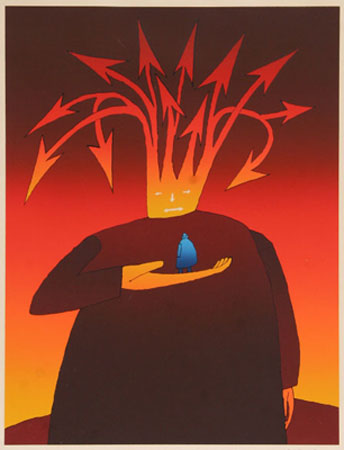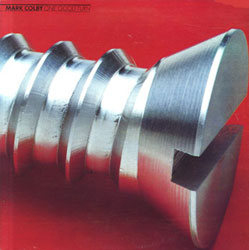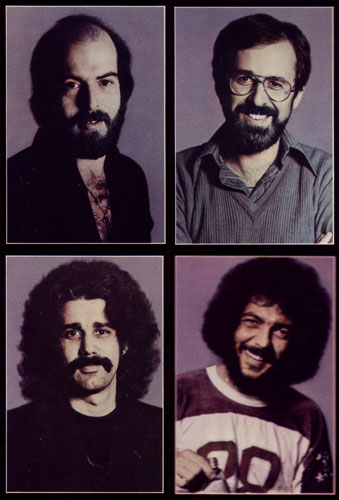Steve Khan's lead sheet:
"Macbeth"(Khan)
During the late '70s, there seemed to be a lot going on for me. Certainly the biggest event was getting signed to Columbia Records by Bob James and being afforded the great privilege of recording "TIGHTROPE" my first album as a leader in 1977. During that same year, I was asked to play on what was to become Maynard Ferguson's album, "NEW VINTAGE." Some lasting friendships with some wonderful musicians were forged during this project. Names like Peter Erskine; Gordon Johnson, Bobby Militello; Biff Hannon; Joe Mosello; Tony Romano(sound engineer); and Mark Colby can be found on this recording.
Not long afterwards, Bob James was launching his Tappan Zee Records label, and one of his first artist signings was saxophonist, Mark Colby. It wasn't long afterwards that I was asked to play on Mark's first album, "SERPENTINE FIRE" which Bob produced and arranged. That was in 1978. I was really excited because Bob asked me if I would submit a tune for the album, and I brought in a piece titled, "Rainbow Wings" which appears on that LP. One year later, 1979, we would be recording Mark's 2nd album, "ONE GOOD TURN," and again, I was asked to bring in a tune. This time, the song was "Macbeth," which was titled after one of Jean-Michel Folon's early seriegraphes. I just loved those vibrant colors and the imagery.
Though my memory for many little details grows foggier with each passing year, I seem to remember Bob telling me that Jaco Pastorius was a good friend of Mark's, and that Jaco was going to play on some of the album. As it turned out, "Macbeth" had a melody during [B2] that was then nudged in the direction of the fretless bass. But, as fate would have it, Jaco never did end-up playing on the album, and so, Mark's longtime bandmate, Gordon Johnson, joined us, and did a beautiful job of interpreting that melody and all the other bass functions. The rest of the small ensemble included: Bob James(Keys); Steve Gadd(Drums); and Portinho(Percussion). As the tune was designed to feature Mark's soprano sax playing, I thought that it would serve the music best if I played both electric 12-string and 6-string steel-string acoustic. And that is now what you hear.
I hadn't listened to this tune in years, perhaps because, sadly, Mark's LP was never released in the CD format, and I suppose that, without having easy access to it, I had just forgotten about it. Until one day someone sent me this YouTube clip and many memories began to return. Once again, I am reminded about the amazing way that things now function and how information finds its way to us in the digital age. But the first thing that comes to mind is just how very influenced my tune was by "Bleeding Orchid," one of Chick Corea's great songs which only appears on the 1971 album, "OUTBACK"(CTI) by saxophonist Joe Farrell. It is my sense that, perhaps, this Chick Corea composition was intended for the first incarnation of Return to Forever which featured: Joe Farrell, Stanley Clarke, Airto, and Flora Purim. The obvious similarities between my tune and Chick's begin with Elvin Jones playing a kind of tango-esque rudimentary sounding marching beat on his snare drum. However, "Bleeding Orchid" is written in 3/4, I would imagine, and my tune was written in 4/4. On "Macbeth," Steve Gadd came-up with one of his typically inventive snare drum-oriented grooves that takes advantage of his musicality, but also his beautiful command of the rudiments on the snare drum. It's hard for me to imagine I guided him in this direction. It is highly possible that Bob James heard something along these lines and suggested it to Steve. But, as I have already stated, my memories of the specific details of this particular recording session are foggy at best.
When I went back to investigate my original lead sheets for "Macbeth" I was just horrified and embarrassed by music writing style during those years. Though, in its way, it was still neat and tidy, now it just seems so primitive and unprofessional looking. My guilt over this state of affairs inspired me to completely rewrite the lead sheet, and that is what you now can view here. Though I sometimes receive complaints from musicians and fans who would prefer to see the lead sheets and transcriptions presented as pdfs done with Finale or Sibelius, I must always tell them that I actually enjoy doing them by hand, and that if one follows the printing GUIDE I offer, it is possible to get a very nice looking print-out. Though, in its way, it was still neat and tidy, now it just seems so primitive and unprofessional looking. My guilt over this state of affairs inspired me to completely rewrite the lead sheet, and that is what you now can view here. Though I sometimes receive complaints from musicians and fans who would prefer to see the lead sheets and transcriptions presented as pdfs done with Finale or Sibelius, I must always tell them that I actually enjoy doing them by hand, and that if one follows the printing GUIDE I offer, it is possible to get a very nice looking print-out.
When I now listen to the [A] section of this tune, I feel as though I should never ever again allow myself to use the rhythms that you see in the keyboard part in bars 3 & 4. Because the tempo is really slow, I decided to write the piece in 4/4 and using 16th-notes instead of writing it all out in cut-time and using 8th-notes. That all too common rhythmic grouping shows-up in far too many of my tunes, especially during that time period. As we arrive at letter [B], I still enjoy hearing the mood that we all created that day, it still feel evocative to me. Best of all, it sets-up Gordon Johnson to play the beautiful melody on his fretless with love and lots of feeling. In bar 1 of [B2], when that melody begins, as the Bob James' Rhodes continues in a similar vein, I have included the little guitar part that I was playing on the electric 12-string, and that I later doubled with my acoustic 6-string, steel-string guitar. One memory does come back to me, and it is as if I can see Bob's smile as he plays those little accented Rhodes hi-lights in the upper register at the end of bar 4 of each phrase. It's a very nice touch from a very experienced, seasoned musician who is always creative on the spot.
From there, the song returns to [A], reprising the main melody. But this time, as we arrive at bar 10, we take the Coda and this brings us to [C] and Mark Colby's first solo section. Here it the feel changes and now the 8th-note equals the quarter-note, and we're reading in cut-time. Steve Gadd shifts to a very insistent quarter-note driven cross-stick feel, as Bob and I play long-tones so that Mark can float over the Gmaj7 to Bm7 chord flow. This chordal motion mirrors what we hard during the [B] melody section. So, at the very least, it is connected to the tune. One thing I also remember about these kinds of recording sessions was that Bob was always very loose about the length of the solo sections and he allowed things to develop and go somewhere, so when he felt that we had reached a moment or two, he probably gave the cue sign by hand and we took the 2nd Ending which changed the time feel back to the original 4/4 and led us back to a reprise of the main melody. One thing I also remember about these kinds of recording sessions was that Bob was always very loose about the length of the solo sections and he allowed things to develop and go somewhere, so when he felt that we had reached a moment or two, he probably gave the cue sign by hand and we took the 2nd Ending which changed the time feel back to the original 4/4 and led us back to a reprise of the main melody.
This time, what I have labeled as [A3] is an abbreviated statement of that same melody. After just 7 bars, we then return to cut-time for letter [D] and Mark solos us out for the Fade over a completely different set of changes: Cmaj7(9/6) for 4 bars to Emaj9/6 for 4 bars. Here, so much of the double-time feel comes more from what Portinho adds with his wood blocks while Steve Gadd is almost playing a half-time feel with lots of syncopated 8th-notes on his hi-hat, the bass drum on beat 1 and a low floor tom on beat 3. With all that going on, it makes it very easy for Bob and me to just be playing long tones, thus allowing the music float underneath Mark's flowing solo lines.
Though as I tried to point-out that, when writing about the solo section at [C], it is related to, and connected to prior melodic material from the [B] section, in general, I have come to view my writing from this time period as using the composed material to give rise to soloing over one or two chords. This as opposed to inventing solo format that put to better usage the chord changes that have appeared before, especially in a section like letter [A]. Even though, in the early incarnation of Return to Forever, the guitar-less version, which many musical people preferred, Chick Corea did compose some tunes that had long solo sections over a chord or two. And "Bleeding Orchid" does not have soloing over the complex melodic and chordal material that appeared in the main melody section. Still, in retrospect, Chick's melodies are so much richer and deeper than anything that I could have composed at that time. Simply put, he's one of our greatest and most prolific composers, and that is only something to which to aspire. Almost a mountain that one really can never climb to the top.
In the end, for my part, I remain ever-grateful to Bob James for having given me the opportunity to bring in a tune for Mark Colby's 2nd album. Looking back, I am very moved that Bob had this kind of confidence in my musical abilities at that time. Honestly, most times, I don't feel that I was ready for that, nor was my musicianship on the same level as the other players. It's very humbling to reflect and perceive a certain truth. As I am writing this in September of 2013, I have certainly had enough time, years upon which to reflect back to those days. I am just going to hope that those who do consistently visit these pages will find something rewarding and interesting in exploring this particular tune.
[Jean-Michel Folon's seriegraph titled, "Macbeth"
Collage: Top: Mark Colby-Bob James Bottom: Steve Khan-Steve Gadd Photos: David Gahr, taken in 1979]
|

